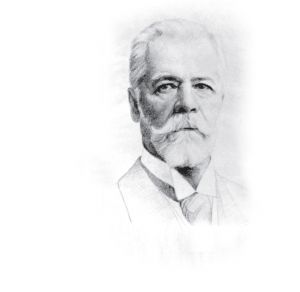Prince Stanisław Jabłonowski (1779–1878) – founder of the asphalt factory and the oil mine in Siary

In the service of Bellona
Stanisław Jabłonowski was born in 1779 in Annopol in the Volhynia region to a princely family with a centuries-old tradition. He died in Lviv in 1878. He was a descendant in a straight line of Hetman (Field Marshall) Stanisław Jabłonowski, who crushed the Turks in the wars waged by king Jan III Sobieski at the end of the 17th century. The young prince did not lack in fighting spirit either. From the age of ten he stayed with his divorced mother, Teodora Walewska, in Paris, where in 1814 he had the opportunity to meet the tsar Alexander I, leading his army into the city. During a ball thrown by his mother, he told him that he wanted to join the army. The young prince was promoted quickly, until 1821, when he resigned after an feud with the sadistic prince Konstanty.
Insurgent
Around 1824, Stanisław married Maria Wielopolska, who brought Kobylanka estate (near Gorlice) as her dowry. He returned to the army when he heard the news about the outbreak of the November Uprising and about the entry of the Russian army into the Kingdom of Poland. For his exploits in the battle of Olszynka Grochowska, he was awarded the Order of Virtuti Militari. As an artillery officer, he took part in the defence of Warsaw in 1831. He was also chief of staff of the Polish Artillery commanded by Józef Bem – from this period come his Memories about stationary battery of the horse artillery of the Polish-Royal Guard (Wspomnienia o bateryi pozycyjnej artyleryi konnej gwardyi królewsko-polskiej).
Industrialist from Siary near Gorlice
After the defeat of the uprising, he emigrated to Galicia. Over time, he settled down in Cracow, and after participating in the riots of the Spring of Nations, he moved to Wrocław. After some time, he returned to Kobylanka. Here he got involved in industrial activities. Around 1850, he founded an asphalt plant in Kobylanka. He used crude oil from oil wells located in Sękowa for asphalt production.
The prince’s surname left its permanent mark in the history of the world oil industry thanks to an event from January 1852. It was then he established the first active oil mine in Pusty Las in Siary near Gorlice. In order to launch it, he hired Silesian miners who started drilling shafts according to the pattern of coal mines which they were so familiar with. Already in 1853, the prince’s enterprise was noticed by Antoni Schwarz, a counsellor of the Krakow Chamber of Commerce, who visited six districts of Western Galicia at that time. In reference to Jabłonowski’s estate, he noted:”The raw products and oil for the manufacture of the composition called asphalt, recently discovered in Kobylanka, an estate of Prince St. Jabłonowski, may also be of value for industrial purposes with the progress of manufacturing. Jabłonowski obtains fluid from black oil after its purification, which burns with a clean, beautiful flame, burning up completely. This fluid could completely replace purified oil heretofore used for fuelling lamps , with the progress of fabrication.”
Petroleum prospector
At about the same time as Zeh and Łukasiewicz, the wealthy landowner began his adventure in oil mining and processing. His actions prove that he also dreamed of an invention that would revolutionize the problem of lighting. In the following years, he intensified efforts to find raw materials. He searched for them, among others, in Siary, Męcina Wielka, Kobylanka and Magdalena. Unfortunately, he did not live to see an heir, to whom he could hand over his petroleum legacy – the marriage with Maria Wielopolska turned out to be childless. Interestingly, at the age of 76, he married her mother Wanda nee Ossolińska of second married name Potocka. As you can guess, there were no offspring for him to see that time either.
Inspirations:
- Pusty las, Regionalna Fundacja Upowszechniania Historii Przemysłu Naftowego w Regionie Gorlicko-Bieckim, [na] [access: 11.09.2015].
- Kopalnia Nafty w Pustym Lesie (The Oil Mine in Pusty las), Regionalna Fundacja Upowszechniania Historii Przemysłu Naftowego w Regionie Gorlicko-Bieckim, [na] [access: 11.09.2015].
- Pabis Tadeusz, Książę Stanisław Jabłonowski (Prince Stanisław Jabłonowski), Regionalna Fundacja Upowszechniania Historii Przemysłu Naftowego w Regionie Gorlicko-Bieckim, [na] [access: 11.09.2015].
- Pabis Tadeusz, Książę Stanisław Jabłonowski (Prince Stanisław Jabłonowski) (1799–1878), Libusza 2010.
- Stanisław Jabłonowski (powstaniec listopadowy) (Stanisław Jabłonowski (November Uprising insurgent)), Wikipedia [access: 11.09.2015]
Source of the photo: Muzeum Przemysłu Naftowego i Etnografii w Libuszy (archive of Anna and Tadeusza Pabis)

